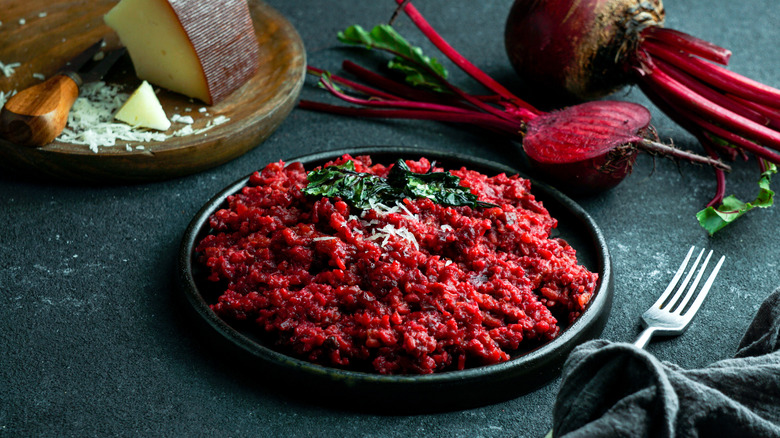How Gordon Ramsay Adds A Dramatic Pop Of Color To His Risotto
Viewers of "Hell's Kitchen" know that Gordon Ramsay is a stickler for a good risotto, and the renowned chef and TV personality is certainly no slouch when it comes to presentation, regardless of what he's making. But one of his risottos has to be seen to be believed. In a video for his 20 million YouTube subscribers, Ramsay shared how to elevate the classic Italian dish by adding a dramatic pop of color.
Cooking with his daughter Tilly, he crafts a roasted beetroot risotto with a deep crimson hue, not only from the namesake ingredient but also from red wine. These additions don't just impart a stunning dash of color to the dish, making it visually striking and enticing, but they also imbue the risotto with complex flavor, lending subtle notes of fruitiness, earthiness, and acidity that complement the richness of the rice (which is enriched with butter and freshly grated parmesan cheese). The best part is, for such dramatic results, it's super easy to pull off.
Gordon Ramsay's tips for perfectly cooked risotto
Gordon Ramsay begins his risotto as usual, sautéing aromatics (shallots and garlic in this case) in olive oil. Then, he adds in the arborio rice, toasting it slightly to enhance its inherently nutty flavor. Instead of spooning in the stock or water right away, though, Ramsay floods the pan with red wine and infuses the rice before incrementally adding the stock. Garnished with some roasted beetroot, the resulting risotto is a beautiful burgundy.
Color aside, risotto can be a tricky dish to get just right. Achieving the perfect creamy consistency while maintaining the individual grains' bite requires patience and attention to detail. Overcooking can result in mushy or gummy rice while undercooking leaves the dish unpleasantly firm. Ramsay shared a few of his best practices for whipping up the perfect risotto, and it starts with the right pan.
Ditch the deep pots and go with a wide, flat pan. This evenly distributes the rice, maximizing its contact with the heat source and enabling each grain to cook uniformly. In a deep pan, the rice tends to clump at the bottom, resulting in inconsistent textures and potentially burned patches.
Another common risotto pitfall comes from rice that's too starchy, which can contribute to a sticky, unpleasant texture. By lightly searing the rice before adding liquids, a technique known as tostatura, it removes moisture and partially seals each grain's outer layer, preventing excessive starch release while still allowing for the absorption of broth.
Other ways to incorporate color into risotto
Risotto, which often presents as creamy, white rice, is the perfect canvas for color. Opt for the Gordon Ramsay route with red wine, or experiment with other hues. Go green with pureed spinach or asparagus, bright red with chopped sun-dried tomatoes or paprika, or purple with purple carrots.
For the adventurous palate, flavorful squid ink can give your risotto a dramatic transformation. This dark, inky liquid, extracted from the sac of squid and cuttlefish, paints risotto with a captivating deep black color. While the color might seem intimidating, the taste is surprisingly subtle, adding a hint of the sea, a touch of saltiness, and a unique umami depth.
On the flip side, saffron can add a touch of luxurious gold to risotto. The world's most expensive spice, saffron is derived from the dried stigmas of a specific crocus flower. When added to risotto, it infuses the dish with a vibrant yellow color and an aromatic, floral fragrance. The flavor is subtle yet complex, with notes of honey, hay, and earthiness.


